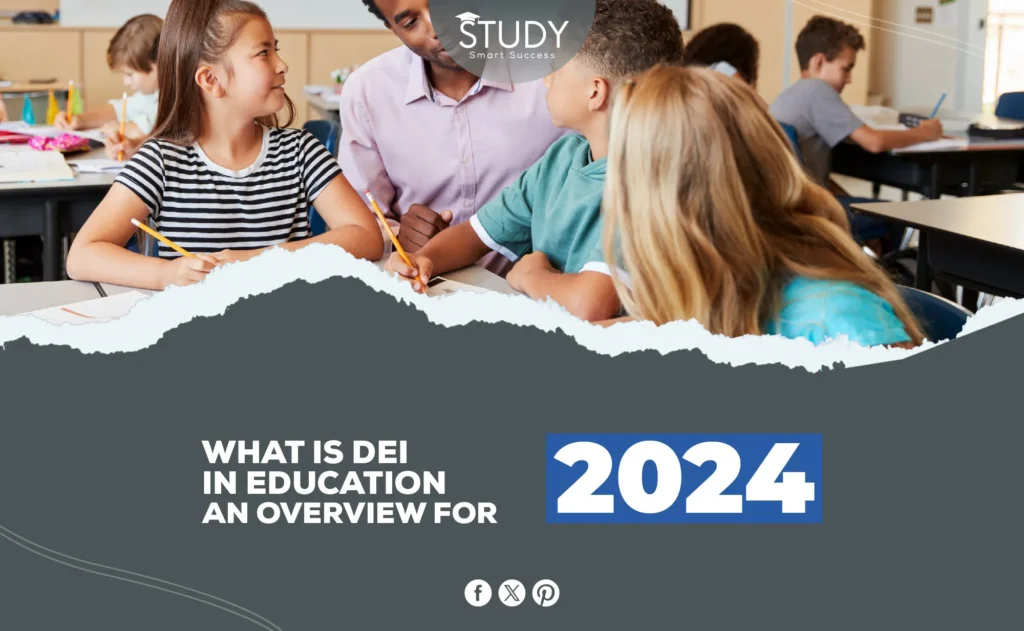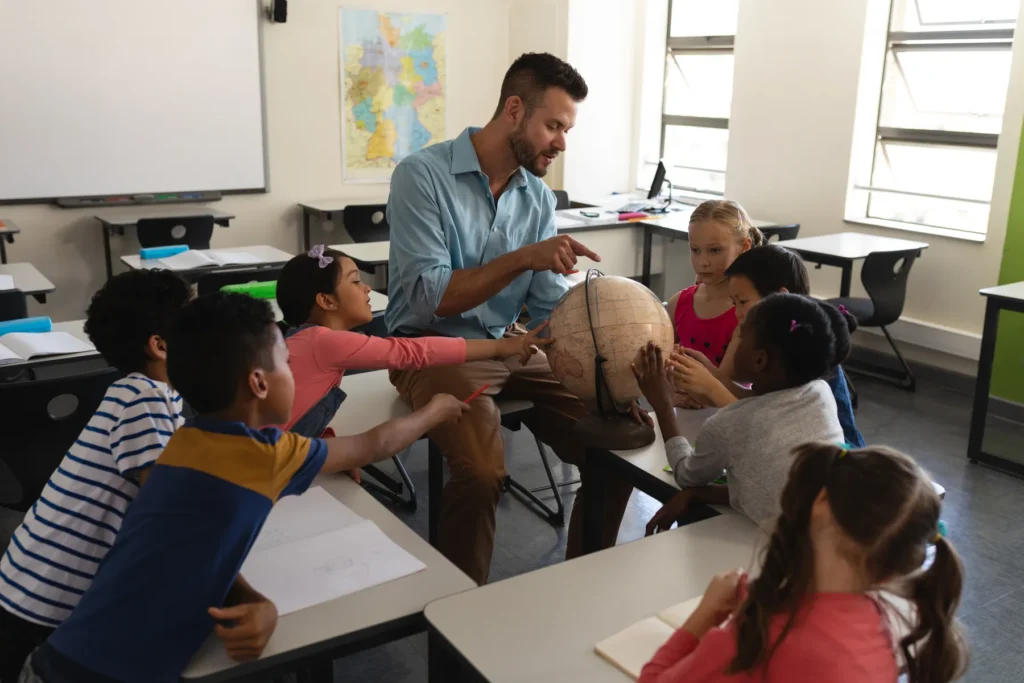(This content is updated on Thursday, 25th of July, 2024, at 18:52.)
Introduction
Education brings out the best in people, not merely imparts knowledge. The previous few years have focused on making education equitable, inclusive, and open to all. Diversity, Equity, and Inclusion (DEI) describe this shift. Further study of DEI in education shows that it is more than a word. This system will transform learning.
What does DEI mean in education?
Diversity, equity, and inclusion in education aim to transform schools. Diversity embraces each student’s color, culture, gender, financial status, abilities, and more. Equity ensures that all students, regardless of background, have equal opportunities and resources. Inclusion is making everyone feel respected, accepted, and involved in learning.
Could you read our latest Blog? Education Resource Strategies
DEI in education aims to create a learning space like the world’s complex fabric, ensuring that every student, regardless of background, has a fair chance to succeed and contribute.
Why Diversity, Equity, and Inclusion (DEI) is Important in Education:
Better Opportunities to Learn:
Diversity in the classroom brings together a wide range of ideas, experiences, and points of view, creating an atmosphere where students can learn from their teachers and each other.
Getting ready for a globalized world:
Exposure to variety helps students prepare for the challenges they will face outside of school by making them culturally capable and ready to live in a globalized society.
Getting Past Obstacles:
Equity ensures systemic hurdles to education are taken down so that all kids have the same chances. This isn’t just about fair chances; it’s also about understanding and fixing structural and historical differences.
Whole-person growth:
Inclusion considers students’ social and mental health as well as academic performance. If they feel included, people are more likely to learn, which boosts growth. To teach in the 21st century, DEI must be more than concepts. We must view it as a fundamental paradigm change.
Understanding Diversity in Education:
Definition of Diversity:
Diversity in education goes beyond homogeneity. It acknowledges and celebrates student diversity. We must recognize each student’s features and experiences as well as color, gender, and culture.
For detailed information about Diversity in Education.
Understanding Equity in Education:
Definition of Equity:
Education equity means all kids, regardless of background, should have the resources to succeed in school and life. It’s more than equality—it helps kids with their issues in school.
For more detailed information about Equity in Education.
Understanding Inclusion in Education:
Definition of Inclusion:
Inclusion in education is more than just having access; all students should be actively involved in the learning process, no matter their background, skills, or differences. It’s about making a place to learn where everyone feels like they fit and where differences are recognized and celebrated.
For more detailed information about Inclusion in Education.
Strategies for Implementing DEI in Education:
Diversity, Equity, and Inclusion (DEI) are not just ideas; they are rules schools must follow and build into their structure. Putting DEI into action takes a team effort, and teachers are critical in making settings welcoming for everyone. Here, we look at five important ways to bring about significant changes.
Professional Development for Educators:
DEI needs to invest in instructors’ professional development. Workshops, training, and seminars help teachers create friendly classes. It requires diversity education, cultural competence, and inclusive education best practices.
Teachers can change how they teach to meet their students’ needs when they have a chance for continuous learning. By encouraging a culture of lifelong learning, schools train teachers who are both excellent at their jobs and good at making learning places that are fair and open to everyone.
Inclusive Curriculum Development:
Inclusive programs are essential to DEI in education. Curriculum should encompass other viewpoints, experiences, and histories, not simply Eurocentric ones. Choose items that depict diverse races, ethnicities, genders, and talents. Textbooks and educational materials should represent student diversity.
It’s not a one-time thing to make a program inclusive; it’s an ongoing process that changes as society does. Regularly reviewing and updating educational material ensures it stays up-to-date, relevant, and aligned with equity and diversity principles.
Culturally Responsive Teaching Practices:
Adaptable, culturally responsive education respects students’ ethnicity. Customizing lessons for each student helps. Use examples from diverse cultures, accommodate varied learning techniques, and measure student comprehension. Culturally relevant teaching creates relatable classes. Fun learning makes people feel valued and included.
Creating Safe and Supportive Learning Environments:
A setting that is safe and supportive is necessary for learning to happen. This means dealing with problems of bias, bullying, and discrimination. For DEI to work, there needs to be an atmosphere of acceptance and understanding where students can be themselves without worrying about being judged.
Educators can help make schools more welcoming by encouraging open communication, enforcing anti-bias rules, and taking action when discrimination happens. When schools put the emotional health of their kids first, they create a positive and welcoming culture for everyone.
Community Involvement and Partnerships:
It’s not just the teachers’ job to work on DEI; everyone needs to do their part, and it has to happen outside of school, too. Partnerships and community participation are essential for taking a broad view of diversity and inclusion.
By getting involved in the community, schools can learn about the different needs and points of view of the families they serve. Partnerships with the community can also give students access to more tools, mentorship programs, and support networks that make learning better for all of them.
Challenges and Potential Obstacles:
Getting schools to embrace Diversity, Equity, and Inclusion (DEI) is good but challenging. Seeing and dealing with these problems is essential to make lasting changes.
Resistance to Change:
When schools adopt DEI programs, people prefer the same, which causes problems. This reluctance can be caused by stuck-in-the-past thinking, fear of the unknown, or refusal to question rules. To overcome this issue, DEI’s benefits must be highlighted. An open environment, success stories, and excellent student results can assist overcome opposition.
Lack of Awareness and Understanding:
DEI is hampered by stakeholder ignorance. This includes teachers, administrators, parents, and students. DEI myths must be dispelled, and their value must be promoted through comprehensive training and teaching. DEI awareness and support are raised through workshops, webinars, and campaigns.
Institutional Barriers:
Institutional impediments within educational systems can impede progress toward DEI. These may include obsolete policies, biased evaluation methods, or a lack of decision-maker diversity. Reevaluating and reforming policies to meet DEI principles is needed to overcome institutional impediments. Diverse and inclusive decision-making bodies can also help overcome structural barriers.
Overcoming Challenges through Collaboration and Ongoing Dialogue:
Getting people to work together and keep talking is the key to resolving problems arising when adopting DEI. Take a look at these strategies:
Collaborative Decision-Making:
Include people from a range of backgrounds in the decision-making process. This lets people with different viewpoints participate and ensures that choices are made that meet the needs of everyone in the community.
Open and Honest Communication:
Encourage people to discuss the pros and cons of DEI projects openly and honestly. This can be done by holding regular town hall meetings, feedback sessions, and places where people can constructively discuss their problems.
Professional Development:
Give teachers and administrators chances to keep improving their skills. It means learning how to be culturally competent, teaching in a way that includes everyone, and dealing with people who want to stay the same.
Celebrate Success Stories:
Bring attention to and celebrate success stories in the education field. Sharing and recognizing the good results of DEI programs can motivate others to face their problems and use the power of diversity, equality, and inclusion to improve things.
Future Directions and Continued Advocacy:
The world of education is constantly changing, and the principles of Diversity, Equity, and Inclusion (DEI) are at the front of this path. Looking ahead, the future of DEI in education looks bright with more growth, new ideas, and a dedication to making learning spaces welcoming for everyone.
The Evolving Landscape of DEI in Education:
DEI in education has moved from diversity to equity and inclusion. Schools must incorporate DEI into curriculum and hiring. Power dynamics, representation, and inclusive environments for all students will receive deeper structural changes.
As global perspectives become increasingly vital, DEI in education will include international perspectives to prepare students for a diverse and connected world. Virtual learning platforms, technology integration, and new teaching methods are needed to make education more inclusive.
Ongoing Research and Advancements:
DEI in education will evolve with research and developments. Researchers will evaluate DEI efforts and identify best practices. This research will help build evidence-based solutions and improve policies and practices.
Technology will bring new DEI tools for schooling. Inclusion and tailored learning will be achieved using virtual reality, artificial intelligence, and data analytics. DEI concepts in educational research will also improve understanding of academic performance and human growth.
Importance of Sustained Efforts for Long-term Impact:
Progress has been made, but long-term impact requires ongoing work. True diversity, equity, and inclusion in education need long-term commitment. Educational institutions must incorporate DEI concepts into their beliefs, policies, and practices to promote inclusion as a core value.
Conclusion
In conclusion, understanding and implementing Diversity, Equity, and Inclusion (DEI) in education is a radical shift in how we view and learn. DEI is more than a list of principles—it is a commitment to create educational places where everyone can thrive and contribute to a diverse and interconnected world.
DEI in education embraces each student’s rich tapestry of diversity, breaking from traditional norms. It values all aspects of a student’s identity, not just ethnicity, culture, gender, and ability.





